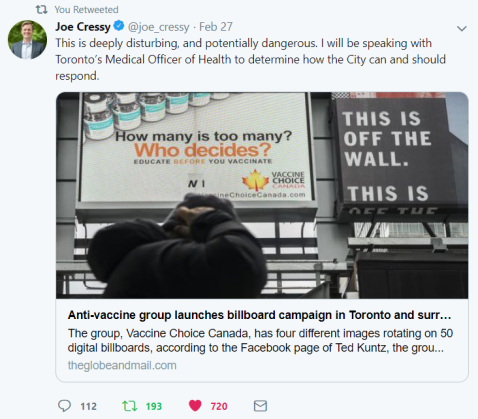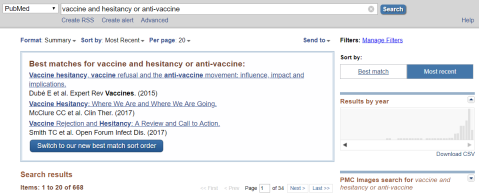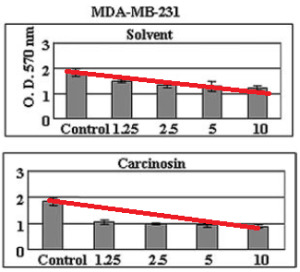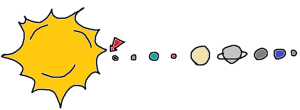Vaccine/Anti-Vaccine Twitter Thread Analysis – Defining the Scope of the Problem

On February 26th, 50 anti-vaccine billboards appeared across Toronto which the advertising company has committed to taking down the following day (though refusing to comment on the rationale behind their decision). You can see the article here: https://www.theglobeandmail.com/canada/article-billboards-posted-by-anti-vaccine-group-in-gta-being-removed/
Toronto City Councillor tweeted the above. The tweet received a fair bit of attention with 193 RTs and as I clicked to see the comments on February 27th the first few didn’t draw much attention as they were generally of people agreeing with the need to remove the billboards. But as I continued reading a different picture emerged. I decided to use this as a small case study to breakdown the thread and try and quantify the scope of the anti-vaccine movement problem.
Unique participants: 121
Pro-vaccine: 70
- Most pro-vaccine posts were short, one line messages without media or graphics.
- Main arguments used were mainly two:
- This is dangerous advertising and a risk to public health.
- Report to advertising standards/this is irresponsible advertising.
Anti-vaccine: 37
- They posted the majority of tweets.
- They posted more elaborate messages, many posts included pictures, graphics and links to anti-vaccine websites.
- One of the more frequently occurring arguments to leave the billboards up was to not encroach on the freedom of speech.
- Some arguments were:
- I’m for vaccinating against dangerous diseases but not the dangerous ones.
- The medical establishment is corrupt.
- The pharmaceutical industry is corrupt.
- Herd immunity is not real.
- Freedom of choice, let parents decide if they want to vaccinate their kids.
- It’s a government conspiracy.
- Vaccines are passed on genetically from last generations [I must admit, I haven’t heard this one yet].
- Our government is a dictatorship.
- There are no disease outbreaks [possibly referring to recent measles outbreaks] – stop the hysteria.
- Our government is fascist.
- Doctors don’t vaccinate their kids.
- 9/11-Hitler conspiracy [yes, it’s quite bizzare].
- It’s a government conspiracy.
- We’re giving too many vaccines.
- There are dangerous chemicals in vaccines.
- Our government is communism, there’s no free speech.
- Don’t just take down billboards, address people’s concerns/vaccine-injury needs to be known widely to the public.
- What’s next, you’re going to take away my property [implying we’re in a communist regime].
Indetermined: 14
- Unfortunately, 4/14 of these used this as a forum to attempt and discredit the city councillor (which arguably can place them into the anti-vaccine group since it can undermine the main message).
I might have made a few small errors counting and probably missed some arguments. There were many Twitter accounts that may have been fake or even bots (given lack of avatar, very few followers, very recent join date and lack of descriptive handle). The frequency of fake accounts, subjectively, is higher on the anti-vaccine side (but some also on the pro-vaccine side).
I think it’s safe to conclude that those pushing anti-vaccine agenda clearly have better communication skills where they make effective use of media and visuals as well as frequent linking to external sources. More likely, of course, is that they are willing to invest the time to disseminate their message. The range of arguments also appeals to a wide range of anxieties: anywhere from concern parents to extreme-right ideologues and conspiracy theorists.
There’s a wealth of publication addressing vaccine hesitancy and the arguments used, a quick PubMed search gives almost 700 results but looking at the results by year research into the subject really started in 2012/2013 (which is now almost 2 decades since Andrew Wakefield’s fraudulent publication).

Some (rather random) picks:
Viral suspicions: Vaccine hesitancy in the Web 2.0.
https://www.ncbi.nlm.nih.gov/pubmed/30816729
The Anti-vaccination Movement: A Regression in Modern Medicine
https://www.ncbi.nlm.nih.gov/pmc/articles/PMC6122668/
Facebook Recruitment of Vaccine-Hesitant Canadian Parents: Cross-Sectional Study
https://www.ncbi.nlm.nih.gov/pmc/articles/PMC5547248/
The overlooked dangers of anti-vaccination groups’ social media presence
https://www.ncbi.nlm.nih.gov/pmc/articles/PMC5489284/
Vaccine Criticism on the World Wide Web
https://www.ncbi.nlm.nih.gov/pmc/articles/PMC1550643/
Ultimately though, given the diversity of responses in a single Twitter thread, how is it possible to address the issue at the population level?
Homeopathy or how to misapply evidence based medicine – Part 2
Homeopathic remedies don’t follow conventional chemistry, it seems they prefer cosmic proportions [1]. What about what happens in-vitro? Apparently, some places use homeopathic preparations to treat cancer, so they decided to test what homeopathic remedies can do in-vitro to the cancer cells [2].
1. Can HPLC detect homeopathy?
They ran the solvent on HPLC and got only 1 peak, they then tested if “shaking” the solvent would change the chromatogram. It didn’t. Shaking chemicals doesn’t change their HPLC profile, unless you call it “succuction” instead of “shaking”, so that might have some magical powers. But the really neat part comes next:
“All four remedies had very similar HPLC chromatograms to each other, with only trace amounts of limited number of peaks. They were not significantly distinct from the solvent and they lacked the distinct peak seen in the solvent.”
So… they weren’t different, but they weren’t the same as the solvent? What did these “trace amounts…peaks” look like? What do the authors conclude to be “not significantly different”?
HPLC doesn’t work by some magical means. It uses distinct wavelengths of light and detects how the sample molecules absorb this light [3]. If the chances of any molecules of a homeopathic remedy being in the sample are infinitesimally small, then what is the HPLC detecting [1]? Perhaps there are impurities in the sample? Did the samples get contaminated?
If we believe homeopathic theory that water has “memory” then HPLC shouldn’t be detecting anything in the homeopathic samples. It shouldn’t be detecting anything, because there shouldn’t be any compounds to absorb any wavelengths of light apart from what the alcohol/water in the mixture could absorb.
But even more suspicious is the fact that the authors don’t demonstrate the HPLC spectra to certify that indeed there were no differences. Showing these spectra is not difficult, the HPLC produces graphs that are easily visually compared [4].
2. Contaminants, I mean homeopathy, in a sample can affect cancer cells?
Since they felt that HPLC analysis was necessary but failed to show the data, I feel no further discussion is really necessary. For the sake of the argument however let’s look at some other aspects of the study.
The first question of course is – where was their positive control? We have many substances known to be cytotoxic, why didn’t they have this control? Would the extent of cyctotoxicity be much greater with established cytotoxic agents? For example, why not use a chemotherapy agent like doxorubicin or cyclophosphamide?
Finally, it doesn’t matter what you add to the cells in-vitro, some cytotoxicity will be evident. This is evident from the fact that any cell line has optimal growth conditions. Once the optimal growth conditions are altered, the cells begin to die. In this study they used 87% alcohol and added up to 10 microliters/ml of cell culture [2]. Just to give you a proportion that’s approximately 1% alcohol by volume! Say you weigh 70kg and you drank 700 mL of 87% alcohol (that’s like drinking two 26’ers of vodka), do you think that would induce some cell death?
Notice how in both cases adding more alcohol to the cells kills more cells consistently. Notice also that the differences between each concentration between the two graphs are very very small, but since HPLC probably showed some contamination, adding high concentrations of contaminated alcohol will kill slightly more cells. No surprises there.
Finally, cytotoxicity in non-cancerous cells indicates that something other than homeopathy was used because the claim of homeopathy is that it has no side-effects compared to conventional medicines. If whatever they used in this study could harm non-cancerous cells means that it will have unfavorable side effects.
3. Prior plausibility is important
The point I’m trying to make is that if the chances of something working are impossibly small and then it all of a sudden works, it’s suspicious. But attention grabbing graphs in papers are much easier to get distracted by than to simply analyse the underlying principles. I would not question the cytotoxicity of chemotherapy agents in-vitro because the likelihood that they kill cells is very high. I question homeopathic remedies killing cells because it makes me think that some contaminant made its way into the cultures in the process of dilution. This contaminant could have altered the optimal growth conditions beyond what the solvent could have done by itself.
References
1. https://sciencepharmer.wordpress.com/2013/06/03/homeopathy-or-how-to-misapply-evidence-based-medicine-part-1/
2. Frenkel M, Mishra BM, Sen S, Yang P, Pawlus A, Vence L, Leblanc A, Cohen L, Banerji P, Banerji P. Cytotoxic effects of ultra-diluted remedies on breast cancer cells. Int J Oncol. 2010 Feb;36(2):395-403.
3. How does high performance liquid chromatography work? http://www.waters.com/waters/en_GB/How-Does-High-Performance-Liquid-Chromatography-Work%3F/nav.htm?cid=10049055&locale=en_GB
4. Simirgiotis MJ, Schmeda-Hirschmann G, Bórquez J, Kennelly EJ. The Passiflora tripartita (Banana Passion) fruit: a source of bioactive flavonoid C-glycosides isolated by HSCCC and characterized by HPLC–DAD–ESI/MS/MS. Molecules. 2013 Jan 28;18(2):1672-92. doi: 10.3390/molecules18021672.
Homeopathy or how to misapply evidence based medicine – Part 1
Somewhere out there (not to scale)
In the late 18th century Samuel Hahnemann (a German physician) proposed that “like cures like” [1]. He proposed that if a substance causes disease in a healthy person then a very small amount of the same substance can help a sick person [1].
“Hmm, hold on”, you might say “isn’t this sort of what we do with vaccines?”
Well, let’s look at some chemistry (if you don’t want to see all the math, skip to the conclusion below):
1. How much vaccine is there in each “shot”?
A conjugated polysaccharide vaccine can have a molecular weight anywhere between 10,000 g/mol – 100,000 g/mol [2, 3].
There are 25 micrograms of each polysaccharide isolate in Pneumovax 23 [4]. That’s 23 x 25 = 575 micrograms (or 0.000575 g).
Let’s take 100,000 g/mol as the weight of the polysaccharide (that’s fairly consistent with weight required to make a polymer).
0.000575 g / 100,000 g/mol = 5.75 x 10^-9 mol
How many molecules of vaccine are there in each vaccine “shot”? Avogadro’s number is 6.0221413 x 10^23/mol, so…
(5.75 x 10^-9 mol)(6.0221413 x 10^23/mol) = ~3.5 x 10^15 (that’s 3,500 TRILLION molecules).
So, perhaps “like” can “cure like”, but you still need some molecules to be present. Ok, you need 3,500 TRILLION molecules.
2. Can homeopathic remedies match this chemistry?
Let’s look at a preparation called “China 30” because this product will make another appearance in a later post.
China stands for Cinchona officinalis which is a medicinal plant [5].
The “30” means it has a “potency” of 30C. A potency of 1c is when you take 1 part of something and dissolve it in 100 parts diluent (making a 1:100 dilution). So you repeat this process 30 times. The result is a dilution of 10^-60. Not sure what the Cinchona officinalis preparation itself entails, but I’m going presume there’s some quinine in it. Also not sure how much of the original substance is used, but to be very generous, let’s say they use 1 kg (1000 g) and then dissolve that (which I doubt, but I’m feeling generous today). Quinine HCl salt has a solubility of about 1g/ml in warm water and alcohol [7].
So, quinine’s MW is 396.91 g/mol (quinine hydrochloride [7]). Take 1 kg and you have 2.5 moles of quinine.
2.5 moles would contain (2.5 x Avogadro’s number) 1.5 x 10^24 molecules.
But we had a dilution of 10^-60, so we have to multiply:
1.5 x 10^24 molecules x 10^-60 = 1.5 x 10^-36 molecules/liter. But, there’s no such thing as a 10^-36 of a molecule. Molecules either are or aren’t. So how many liters of this “30C” preparation would you have to drink to get just 1 molecule of quinine? Well…
1 liters / 1.5 x 10^-36 molecules/liter = 6.7 x 10^35 liters.
That seems like a large volume, but how large? Well, there are about 1.4 x 10^21 liters of water on Earth (that’s ALL the water on Earth; oceans, lakes, underground, everything!) [8].
So to get just ONE molecule of quinine from a “30C” preparation of China 30, you would need to drink all the water on Earth 482 TRILLION times. That’s still very hard to imagine.
Ok, the volume of the solar system filling all the space from the Sun to Mercury would be 8.2 x 10^35 liters (I got this by calculating the volume of a sphere with a radius of the distance from the Sun to Mercury, which Google and Wikipedia tell me is 58 million kilometers) [9]. So with a “30C” dilution you would need to drink as much of that preparation as would fill all the space from the Sun to Mercury!
3. What can we conclude about the basic chemistry of homeopathic preparations?
One shot of a Pneumovax 23 vaccine contains TRILLIONS of molecules of the drug and saves countless lives. On the other hand to get ONE molecule of drug from China 30 into your body, you would need to drink so much of it that it would fill all the space between the Sun and Mercury! I guess if you want quinine from China 30, you better get drinkin’!
References:
1. Briggs J.P., Straus S.E. (2012). Chapter e2. Complementary, Alternative, and Integrative Medicine. In A.S. Fauci, D.L. Kasper, J.L. Jameson, D.L. Longo, S.L. Hauser (Eds),Harrison’s Principles of Internal Medicine, 18e.
2. Mallick J. (2009). Extraction and purification of capsular polysaccharide from streptococcus pneumoniae and Escherichia coli for conjugate vaccines preparation – Thesis Paper. [Link to PDF]
3. Ellis RW and Brodeur BR (Eds). (2003). New Bacterial Vaccines (Medical Intelligence Unit). Springer. [Google book link]
4. Lexi-Comp Online (TM). Hudson, Ohio: Lexi-Comp, Inc.; June 02, 2013.
5. Rajan A, Bagai U. SEM studies on blood cells of Plasmodium berghei infected Balb/c mice treated with artesunate and homeopathic medicine China. J Parasit Dis. 2011 Oct;35(2):134-9. Epub 2011 Aug 10. [PubMed Link]
6. Morgan J. Homeopathic Pharmacy. [Link to PDF]
7. The Merck Index. 14th edition.
8. USGC. How much water is there on Earth? http://ga.water.usgs.gov/edu/earthhowmuch.html
9. Have to admit, I just Googled this one.

